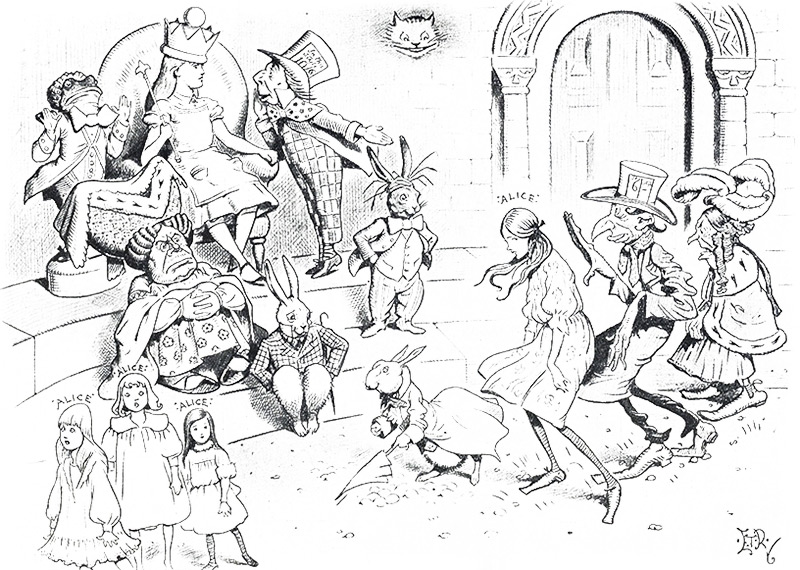Alice...had peeped into the book her sister was reading, but it had no pictures or conversations in it, “and what is the use of a book,” thought Alice, “without pictures or conversations?”
Chapter I

While Carroll welcomed books “of the Alice type”, he most likely would have disliked new artists’ interpretations of Alice itself. Many of his readers agreed, and felt that Tenniel’s illustrations were preferable, as reflected in the Dec. 4, 1907 Punch cartoon “Tenniel’s ‘Alice’ reigns supreme” (at right).
But Alice’s classic status and fantastic elements have been irresistible to artists, from Salvador Dali to Walt Disney. The 1907 Heinemann edition opens with this poem by Austin Dobson:
[...]
Enchanting ALICE! Black-and-white
Has made your deeds perennial;
And naught save “Chaos and old Night”
Can part you now from Tenniel;
But still you are a Type, and based
In Truth, like LEAR and HAMLET;
And Types may be re-draped to taste
In cloth-of-gold or camlet.
Peter Newell was among the first American artists to reinterpret Alice. His illustrations, printed as halftone plates, featured both the archetypal episodes covered by Tenniel, as well as less well-known scenes.
Bour’s minimalist contour drawings imbue this French edition of Alice with an otherworldly feel. Alice au pays des merveilles.
Artist Barry Moser’s hauntingly beautiful woodcuts reveal a much more menacing view of the Alice story.
“I didn’t see ‘Alice’ as a children’s story,” Moser told the Hampshire Gazette in 2012. “To me, it was a much darker tale, and I wanted people to see Wonderland the way Alice saw it – less whimsical and more nightmarish.”
The text was prepared by Carroll scholar and collector Selwyn Goodacre, and side notes printed in red enhance the story for the reader.
Of her Alice-inspired work, book artist Mira Coviensky wrote, “I was particularly interested in translucency and transparency, and what layering does to transform images...The layering of images, and their reflections when the light is at a certain angle, mirrors the layering of time found in Alice, and emphasizes the absurdity of it being always six o’clock and, therefore, always tea-time.”
There have been a number of pop-up and moveable versions of Alice; American pop-up artist Robert Sabuda’s whimsical, stylized reinterpretation of Tenniel’s drawings is not only technically complex but filled with clever details: the pop-up of Alice being showered with playing cards contains two complete, accurate decks.
French artist Anne Bachelier often explores metaphysical dreamscapes in her work; her surreal watercolors for this tête-bêche of Alice and Looking-Glass provide a vivid new interpretation of Alice for the 21st century.